Unit 4-6 answer keys 学术英语答案
- 格式:doc
- 大小:247.00 KB
- 文档页数:45
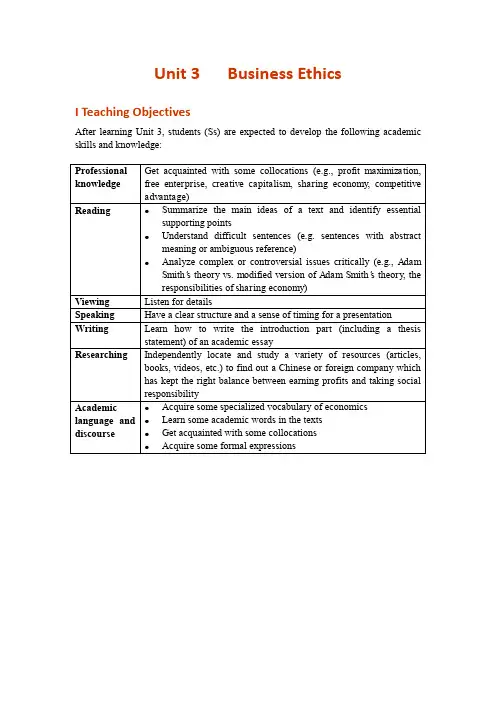
Unit 3 Business EthicsI Teaching ObjectivesAfter learning Unit 3, students (Ss) are expected to develop the following academic skills and knowledge:II Teaching Activities and ResourcesReadingText ALead-inTeaching StepsAsk Ss to work in groups and complete the task in Lead-in. Then choose some groups to share their answers with the whole class.Answer Keys (Suggested Answers)1.Corporate Social Responsibility (CSR) can be defined as a self-regulatingbusiness model that helps a company be socially accountable —to itself, its stakeholders, and the public. In other words, it is the continuing commitment by business to behave ethically and contribute to economic development while improving the quality of life of the workforce and their families as well as of the local community and society at large.2.Text AnalysisTeaching Steps1.OverviewAsk Ss to preview Text A before class. Or, allocate some time for Ss to read the text quickly in class. Then invite several Ss to summarize the main idea of Text A.2.In-Depth Analysis1)Show Ss the following words and ask them to contribute to the class as muchas possible with what they know about these words. Provide additional information in Supplementary Information when necessary.•economic system•free enterprise2)Explain some important language points in Language Support to Ss.3)Discuss with Ss the features of the two versions of Adam Smith’s theory bydoing Task 1 in Critical reading and thinking.4)Organize a group discussion about the questions from Task 2 in Criticalreading and thinking. Encourage Ss to think independently, critically and creatively and share their ideas with each other.Supplementary Information1.economic systemAn economic system is a system for producing, distributing and consuming goods and services, including the combination of the various institutions, agencies, consumers, entities that comprise the economic structure of a given society or community. It also includes how these various agencies and institutions are linked to one another, how information goes between them, and the social relations within the system.Two of the basic and general economic systems are market economy and planned economy. Market economy is an economic system in which businesses and individuals decide what to produce and buy, and the market determines quantities sold and prices, whereas planned economy is an economic system in which decisions regarding production and investment are embodied in a plan formulated by a central authority, usually by a public body such as a government agency.Although a planned economy may be based on either centralized or decentralized forms of economic planning, it usually refers to a centrally planned economy.2.free enterpriseFree enterprise refers to the system of business in which individuals are free to decide what to produce, how to produce, and at what price to sell.Language Support1.Most academics today subscribe to the following modified version of AdamSmith’s theory:…(Para. 2)In the text, the phrase “subscribe to”means “agreeing with or supporting (an opinion, theory, etc.)”(同意;赞成).e.g. I subscribe to the idea that voting is my civic duty.She subscribes to the theory that some dinosaurs were warm-blooded andothers were cold-blooded.It can also refer to “paying money to get (a publication or service) regularly”(订阅).e.g. I subscribe to several magazines.We have subscribed to an evening newspaper.2.These constraints take a number of different forms. …Another set ofconstraints …(Para. 3)Two recent examples dramatically illustrate these points. First, …(Para. 3) Classification is employed to organize things into categories with a single organizing principle, and give examples of things that fit into each category. Here are other commonly-used words and expressions for classification:•The first (kind/type/group/class/etc.) …; the second …; the third …•sort, classify, categorize …•category, group, class, kind …3.Saving the financial system required a bailout of the banks and otherfinancial companies, and that bailout imposed huge costs on the taxpayers, and also helped push the economy into a deep recession. (Para. 5)impose sth. on sb.:i) force something on someone把......强加于e.g. He always imposes his opinion on others.ii) levy a tax or duty征税e.g. It is therefore necessary for governments to impose a higher tax on this kindof food.Here is another usage of the word “impose”:impose on sb.:i) force oneself on others强加于人e.g. Thanks for your offer to help, but I did not want to impose on you.ii) take unfair advantage of 利用e.g. Don’t you think you are imposing on your neighbor when you use histelephone for half an hour?4.be true to one’He is always true to his word and focused on the big picture.Ninety days later, true to his word, the goldsmith brought the crown.5.To date, Buffett has contributed more than $6 billion, and over time he isscheduled to contribute additional stock that is now worth in excess of $40 billion. (Para. 7)in excess of: greater than, more than 超过e.g. Luggage in excess of 100 kg will be charged extra.This plane can reach speeds in excess of 1000 kilometers an hour.Answer KeysCritical reading and thinkingTask 1 / Overview1The original version:The invisible hand; Profit maximization; Free enterprise systemThe modified version:the wealth of its stockholders; the best economic system; constraints2Argument 11) a wide range of regulations are imposed2) assessing costs on companies; BP oil spillArgument 21) behave ethically; value and reputation2) Don’t Be Evil3) creative capitalism4) contributed more than $6 billionTask 2 / Points for discussion (Suggested Answers)11) Yes, I agree. Because:• Earning profit is the main aim of every economic activity. A business is an economic activity and hence, its main aim should be to earn profit.• Profit is a measure of eff iciency and economic prosperity of the business. This justifies the concept of profit maximization.• Economic conditions do not remain the same all the time. A business can retain its profit so that it can survive the adverse situations in the future. Profit gives protection against future risks and uncertainties.• Profit is the main source of finance for growth and expansion. Profit is essential for the business in order to invest in new business propositions.• Profitability is essential for fulfilling the social goals of the business. With profit maximization a business can do socio-economic welfare and follow its policies of corporate social responsibility.2) No, I don’t agree. Because:Business should do anything they can to make a profit, but never at the cost of human welfare and natural environment. Human welfare must be considered as important as profit making. A business is successful to the extent that it provides a product that contributes to happiness in all forms. As a matter of fact, the great value of a business should be morally associated with consumer’s satisfaction and safety. On the other hand, businesses of great value should not be blind to their moral obligations of protecting the natural environment.2 Yes, it is a very effective way for society to impose such regulations to prevent companies from engaging in practices that hurt society. For most businesses their ultimate goal is to make profits. It is true that most businessmen try to abide by the laws while making profits. However we have to admit that there are some who use every means to make as much money as possible, even regardless of the interests ofemployees, communities, and environment. Therefore, the regulations such as penalties and suspension for internal rectification should be imposed to deter companies from unlawful practices.3 Yes, having a good reputation with customers, suppliers, employees and regulators is essential if value is to be maximized. Business success is associated with many entities, such as customers, suppliers, employees and regulators. If customers are satisfied with your products and service, they will be loyal to your company. If suppliers provide you with qualified products, your business will operate well. If employees are treated well, they will work very hard and are willing to be part of your company. If regulators are certain that your company acts fairly and follows rules, your company will develop sustainably. All above depends on whether the business is continually operating with society’s interests in mind and maintaining a good reputation.Language building-upAnswer keysTask 1 / Specialized vocabulary11 纳税人2 自由企业制度3 股东4 经济体制5 市场力量;市场调节作用6 金融机构7 stock price 8 mission9 corporate motto 10 assets11 profit maximization 12 financial system21 financial institutions2 free enterprise system3 assets4 Taxpayers5 stockholder6 profit maximization7 economic system 8 market forcesTask 2 / Academic vocabulary1. principal2. dramatically3. academics4. maximization5. framework6. range7. compensate 8. transfer9. inadequate 10. constraintsTask 3 / Collocations1. subscribe to2. striving to3. imposing …on4. go out of business5. as a whole6. engaged in7. go hand in hand with 8. in excess ofTask 4 / Formal English1 insights2 subscribe to3 imposes4 adverse5 mission6 philanthropic7 donated 8 famedTranslation of Text A达到适当的平衡在1776年,亚当·斯密描述了一只“看不见的手”是如何引导企业追求利润的,而这只手会引导企业做出有利于社会的决策。
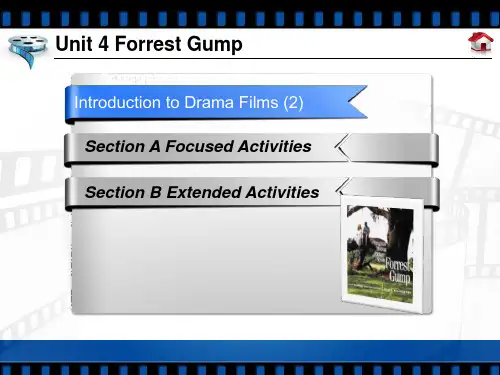
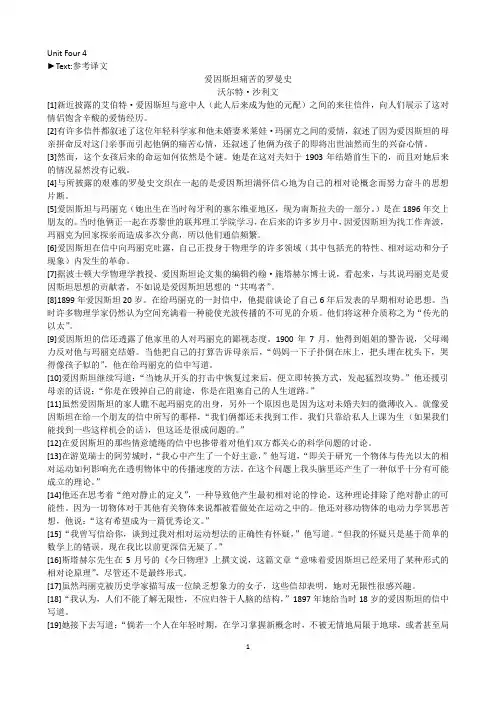
Unit Four 4►Text:参考译文爱因斯坦痛苦的罗曼史沃尔特·沙利文[1]新近披露的艾伯特·爱因斯坦与意中人(此人后来成为他的元配)之间的来往信件,向人们展示了这对情侣饱含辛酸的爱情经历。
[2]有许多信件都叙述了这位年轻科学家和他未婚妻米莱娃·玛丽克之间的爱情,叙述了因为爱因斯坦的母亲拼命反对这门亲事而引起他俩的痛苦心情,还叙述了他俩为孩子的即将出世油然而生的兴奋心情。
[3]然而,这个女孩后来的命运如何依然是个谜。
她是在这对夫妇于1903年结婚前生下的,而且对她后来的情况显然没有记载。
[4]与所披露的艰难的罗曼史交织在一起的是爱因斯坦满怀信心地为自己的相对论概念而努力奋斗的思想片断。
[5]爱因斯坦与玛丽克(她出生在当时匈牙利的塞尔维亚地区,现为南斯拉夫的一部分。
)是在1896年交上朋友的。
当时他俩正一起在苏黎世的联邦理工学院学习,在后来的许多岁月中,因爱因斯坦为找工作奔波,玛丽克为回家探亲而造成多次分离,所以他们通信频繁。
[6]爱因斯坦在信中向玛丽克吐露,自己正投身于物理学的许多领域(其中包括光的特性、相对运动和分子现象)内发生的革命。
[7]据波士顿大学物理学教授、爱因斯坦论文集的编辑约翰·施塔赫尔博士说,看起来,与其说玛丽克是爱因斯坦思想的贡献者,不如说是爱因斯坦思想的“共鸣者”。
[8]1899年爱因斯坦20岁。
在给玛丽克的一封信中,他提前谈论了自己6年后发表的早期相对论思想。
当时许多物理学家仍然认为空间充满着一种能使光波传播的不可见的介质。
他们将这种介质称之为“传光的以太”。
[9]爱因斯坦的信还透露了他家里的人对玛丽克的鄙视态度。
1900年7月,他得到姐姐的警告说,父母竭力反对他与玛丽克结婚。
当他把自己的打算告诉母亲后,“妈妈一下子扑倒在床上,把头埋在枕头下,哭得像孩子似的”,他在给玛丽克的信中写道。
[10]爱因斯坦继续写道:“当她从开头的打击中恢复过来后,便立即转换方式,发起猛烈攻势。
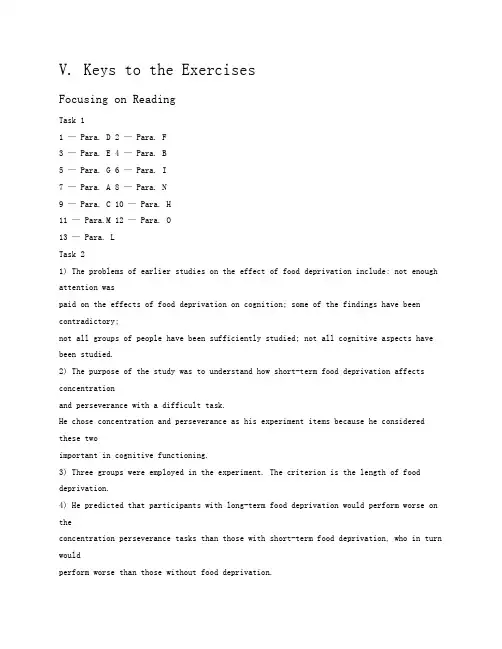
V. Keys to the ExercisesFocusing on ReadingTask 11 — Para. D2 — Para. F3 — Para. E4 — Para. B5 — Para. G6 — Para. I7 — Para. A 8 — Para. N9 — Para. C 10 — Para. H11 — Para.M 12 — Para. O13 — Para. LTask 21) The problems of earlier studies on the effect of food deprivation include: not enough attention waspaid on the effects of food deprivation on cognition; some of the findings have been contradictory;not all groups of people have been sufficiently studied; not all cognitive aspects have been studied.2) The purpose of the study was to understand how short-term food deprivation affects concentrationand perseverance with a difficult task.He chose concentration and perseverance as his experiment items because he considered these twoimportant in cognitive functioning.3) Three groups were employed in the experiment. The criterion is the length of food deprivation.4) He predicted that participants with long-term food deprivation would perform worse on theconcentration perseverance tasks than those with short-term food deprivation, who in turn wouldperform worse than those without food deprivation.The result was that food deprivation had no significant effect on concentration, and a significantTeacher’s Manual of an Integrated Academic English Course IV130effect on perseverance time, with the 12-hour group spending significantly less time on theperseverance task than either the control group or the 24-hour group, with no significant differencebetween the latter two groups.5) It was explained that the participants in the 12-hour group gave up more quickly on theperseverance task because of their hunger produced by the food deprivation, while the 24-hourgroup had developed “learned industriousness”. Another explanation was the motivational state ofparticipants, for the 12-hour group took the tests at 10 p.m., a prime time of the night for businessand socializing rather than for working on the puzzle.The first limitation of the study was the time of day when the respective groups took the tests, andthe second was the reasons of food deprivation; for example, fasting for religious reasons.Task 31) s 2) q 3) r 4) p 5) n 6) f7) g 8) m 9) k 10) l 11) i 12) j13) h 14) e 15) t 16) d 17) b 18) c19) a 20) o 21) x 22) v 23) w 24) uTask 4SentencesChineseequivalentsSynonyms1) The number of wells is a fair indicator of thedemand for water.指标,指示物index, display, signal, sign2) Body temperatures can fluctuate when you areill.波动,变动oscillate, change, alter, vary,vacillate3) Unemployment is a chronic problem in thiscountry.长期的,慢性的constant, deep-rooted, deep-seated,persistent, ineradicable4) I requested a copy of the form. 请求,要求demand, ask for, appeal for, put infor, desire, pray for, put forward,beg for5) She then proceeded to criticize the way I did it. 开始,继续进行continue, carry on, go on, go ahead, advance, continue6) Consumption of alcohol impairs your ability todrive.损害,削弱spoil, injure, decrease, weaken,damage, worsen, diminish,reduce, reduce, undermine, harm7) We need to designate someone as our spokesperson. 指定,指派name, appoint, choose8) Can my child be medically examined withoutmy consent?同意sanction, approval, assent,permission, agreement,acquiescence9) They’ve been deprived of the fuel necessary toheat their homes.剥夺,使丧失strip, rob, dispossess131Unit 6 The Effects of Food DeprivationSentencesChineseequivalentsSynonyms10) Many slopes are rock fields with sparse vegetation. 稀疏的,稀少的scarce, meager, sporadic, scattered, scanty11) He surmised that he had discovered one of theillegal streets.猜测,推断infer, guess, speculate, deduce,conclude, predicate, theorize12) Freud postulated that we all have a death instinct. 假定,认为presume, suspect, assume, presuppose, suppose, hypothesizeThe most formal ones are: fluctuate, oscillate, vacillate, ineradicable, undermine, sanction,acquiescence, sparse, meager, sporadic, surmise, hypothesizeTask 51) According to some researchers, most of the results so far prove that short-termfasting does notaffect cognitive function very much. However, it is too early to draw the conclusion because there isnot enough research on the cognitive functions such as concentration and perseverance. 2) In general, we found our hypothesis supported by the data, as 12 hours of food deprivation wouldgreatly affect perseverance when compared to no deprivation. Unexpectedly, 24 hours of fooddeprivation did not influence perseverance much when compared with the control group.3) We guess that the participants who were deprived of food for 12 hours gave up more quickly on theperseverance task because of hunger. But why didn’t 24-hour food deprivation produce the sameeffect? We assume that it is because of “learned industriousness” which means participants whoperform one difficult task do better on a following task than those who never took the f irst task.Task 6Summary: Future researches on food deprivation and cognition could include the effects of short-termfood deprivation on other aspects of cognition, exploration of longer-term fooddeprivation periods andthe effects of food deprivation on learned industriousness.Task 7Food deprivation has been found to affect people’s ability to focus on a task in previous studies, butnot much attention has been paid to the effects of food deprivation on cognition.①This study intendedto explore how short-term food deprivation affects concentration and perseverance with a difficulttask.②Qualified participants were divided into the control group(with no food deprivation), 12-hourfood deprivation group and 24-hour food deprivation group and they were assigned tofinish theconcentration tasks and perseverance tasks.③It was found that food deprivation had no significant effecton concentration, 12 hours of food deprivation greatly affected perseverance when compared to nodeprivation while 24 hours of food deprivation did not influence perseverance much.④“ Learnedindustriousness” and the motivational state of participants were the possible explanations for theresults.⑤The study provides some insights into the cognitive and physiological effects of skipping meals.(Continued )Teacher’s Manual of an Integrated Academic English Course IV132① the objective ② methods used ③ findings④ explanation ⑤ implicationTask 8(omitted)Task 9(omitted)Task 10(omitted)Research Paper WritingTask 1Function: Describe the outline of the talkFunction: Introduce the topicFunction: Indicate the shift from one idea to anotherFunction: Giving closing remarksFunction: Summarize the talkTask 2Will our city be buried under the sea in one thousand years time? It sounds funny but with theeffects of global warming becoming more and more serious, this may become true in the future. I’mgoing to discuss with you today the effects of global warming. I will concentrate on the three effects ofglobal warming in my presentation today: first, global warming causes melting glaciers and rising sealevels; second, global warming leads to climate change and has an impact on wild animals’ behaviorand habitat; the last effect is the retreating snowlines and death of some species of trees.Task 31) How many hours of sleep did you get last night?The lecture began with the question to arouse the listeners’ interest.2) The major points are the causes of sleep deprivation and its effects.He presented them in the first paragraph to give the listeners a general view of the content.3) The transitional words: but, however, as a result, also4) To illustrate difficult or abstract points.5) The rhetorical questions:In fact, did you know that more than 30 percent of American adults work more than f ifty hours aweek?How many of you would say that ... that you don’t go to sleep when you should because of the TVor the Internet?Rhetorical questions are used to catch the listeners’ attention.6) Colloquial expressions include: OK, well, let’s, yeah, now, yes, eh, as you can see. 133Unit 6 The Effects of Food DeprivationThe speaker uses them to talk to the audience instead of reading to them.7) The talk differs from a formal essay in several aspects: f irst, the talk uses colloquial words,like well, let’s, OK, etc.; the talk uses simpler language, like short sentences; third, the talk usescontractions, like don’t.Task 4(omitted)Task 5(omitted)Task 6(omitted)Task 7(omitted)Task 8(omitted)Task 9(omitted)Task 10Sentences to elicit questions from the audience:— Are there any questions you’d like to ask?— Feel free to ask questions if you have any.— I’d be glad to answer any questions at the end of my talk.— Alright. Now, any questions or comments?Strategies dealing with questions and answers:— Ask for repetition or clarification if necessary“. Do you mean ...?”— Check that the question is relevant. If not, don’t answer if you don’t want to.“I’m afraid that’soutside the scope of my talk / this session.”— Refer questioner to another person if you can’t answer.“ I don’t think I’m the right person to answerthat. Perhaps (Mr. Holmes) can help ...”— Check that the questioner is satisfied with your answer: eye contact and a pause is often sufficient.“Does that answer your question?”Task 11(omitted)Task 12(omitted)Task 13(omitted)Task 14(omitted)Teacher’s Manual of an Integrated Academic English Course IV134Academic Survival SkillsTask 1Abstract:The study aims to find out the Fudan university students’ knowledge of anthropogenic climatechange. We designed a questionnaire including eight questions and gave it to 40 students, who weredivided into majors and non-majors in different grades. News media was found to be themost populardevice to make sense of information, but the classroom education is more important for majors tounderstand some professional knowledge. Another major finding of this study was that students’understanding of the anthropogenic global warming becomes more comprehensive in pace with gradeincreasing.Introduction:Error 1: It’s an interesting context to study appropriating of knowledge and sense making with respectto anthropogenic global warming.Revised: It is significant to study appropriating of knowledge and sense making with respect toanthropogenic global warming.Error 2: Henning Finsereas and his partners relies on data from the 2005—09 World Values Surveyto examine individual and cross-national variation in perception of seriousness of global warming,and show that a large majority of public in all countries are concerned about the problem of globalwarming.Revised: Henning Finsereas and his partners rely on data from the 2005—09 World Values Survey toexamine individual and cross-national variation in perception of seriousness of global warming, andshow that a large majority of the public in all countries are concerned about the problem of globalwarming.Error 3: Everyone wants to know what terrible things happened to the Earth and what influence to ourlife.Revised: Everyone wants to know what terrible things happen to the Earth and what influence theyhave on our life.Error 4:“ There is strong evidence that the warming of the Earth over the last half-century has beencaused largely by human activity, such as the burning of fossil fuels”(Royal Society, 2010:1).Revised: The citation should be included in the references.Error 5: However, environmental change is not just the single factor of anthropogenic influence, andit’s a complex interactions.Revised: However, environmental change is not just the single factor of anthropogenic influence whichresults from complex interactions.Error 6: This paper study how the people reason about and make sense of human-made global warming,based on some interviews with the Fudan University students.Revised: This paper studies how people reason about and make sense of human-made global warming,135Unit 6 The Effects of Food Deprivationbased on some interviews with Fudan University students.Error 7: It shows that the domestication of climate science knowledge was shaped through foursense-making devices: news media, some experts’ disagreement about global warming (included theclassroom education), observations of political inaction, and considerations with respect to everydaylife.Revised: It shows that the domestication of climate science knowledge was shaped through foursense-making devices: news media, some experts’ disagreement about global warming (including theclassroom education), observations of political inaction, and considerations with respect to everydaylife.Error 8: The study is based on eight focus group interviews with the students at school, include theenvironmental science majors and non-professional students.Revised: The study is based on eight focus group interviews with the students at school,including theenvironmental science majors and non-professional students.Error 9: In these groups, with the exception of a smaller number, it was commonly accepted as a factthat anthropogenic global warming is under way.Revised: In these groups, with the exception of a small number, it was commonly accepted as a factthat anthropogenic global warming was under way.Error 10: The paper explores the ways of reasoning that produce these diverse positions, meanwhile,obtain the college awareness of global warming.Revised: The paper explores the ways of reasoning that produced these diverse positions and,meanwhile, it obtains the college awareness of global warming.Conclusion:Error 1: The results of questionnaire provide the following findings.Revised: The results of the questionnaire provide the following findings.Error 2: Because global warming is a hot topic, whether it is professional or not professional students,the majority are very concerned about the climate change.Revised: Because global warming is a hot topic, the majority of the students, professional or nonprofessional,are very concerned about climate change.Error 3: Furthermore, strong f low of information with the development of networks and smart phone,contribute to the people understanding of various academic fields, even some highly specializedknowledge.Revised: Furthermore, the strong f low of information brought by the development of networks andsmart phones contributes to people’s understanding of various academic fields, even some highlyspecialized knowledge.Error 4: The information resource has diversiform form, such as news media, classroom education,government documents and considerations with respect to everyday life.Revised: The information resource has diverse forms, such as news media, classroom education,government documents and considerations with respect to everyday life.Teacher’s Manual of an Integrated Academic English Course IV136Error 5: News media is the main resource in today’s information age. But for majors in university,classroom education gives more professional knowledge and correct sense-making. Revised: News media is the main resource in today’s information age, but for majors in university,classroom education gives more professional knowledge and correct sense-making.Error 6: So many sense-making devices give high-capacity information to people, and it’s not allsources of information have meticulous certification.Revised: So many sense-making devices give high-capacity information to people, but not all sourcesof information have meticulous certification.Error 7: Perhaps, the reason is that college atmosphere more open compared to a high school education,and give the opportunity to exchange various academic fields.Revised: Perhaps the reason is that college atmosphere is more open compared with high schooleducation, and gives the opportunity to exchange various academic fields.References:Error 1: BeritKvaloy, HeningFinseraas, OlaListhaug, 2012. The publics’ concern for global warming:A cross-national study of 47 countries. Journal of Peace Research, 49 (1), 11—22. Revised: Kvaloy, B, H. Finseraas and O. Listhaug. 2012. The publics’ concern for globalwarming: Across-national study of 47 countries. Journal of Peace Research, 49 (1): 11—22.Error 2: LeeAnnKahlor, Sonny Rosenthal, 2009. If we seek, do we learn?: predicting knowledge ofglobal warming. Science Communication, 380 originally published online 7 January 2009. Revised: Kahlor, L. and S. Rosenthal. 2009. If we seek, do we learn?: predicting knowledge of globalwarming. Science Communication, 380 originally published online 7 January 2009.Error 3: LI LiJuan, WANG Bin, ZHAOTianJun, 2007. Impacts of external forcing on the 20th centuryglobal warming. Chinese Science Bulletin, 52(22), 3148—3154.Revised: LI, LiJuan, WANG Bin, ZHAOTianJun, 2007. Impacts of external forcing on the 20th century global warming. Chinese Science Bulletin 52(22): 3148—3154.Error 4: Nicholas Smith, Helene Joffe, 2013. How the public engages global warming: A socialrepresentations approach. Public Understanding of science, 22, 16—32.Revised: Smith, N and Helene Joffe. 2013. How the public engages global warming: A social representations approach. Public Understanding of science 22: 16—32.Error 5: W. S. Broecker, 2006. Global warming: take action or wait? Chinese Science Bulletin, 51(9),1018—1029.Revised: Broecker, W. S. 2006. Global warming: take action or wait? Chinese Science Bulletin, 51(9):1018—1029.137。
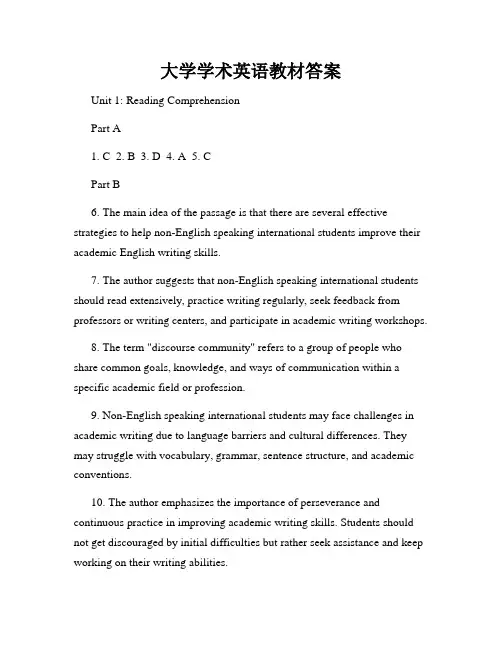
大学学术英语教材答案Unit 1: Reading ComprehensionPart A1. C2. B3. D4. A5. CPart B6. The main idea of the passage is that there are several effective strategies to help non-English speaking international students improve their academic English writing skills.7. The author suggests that non-English speaking international students should read extensively, practice writing regularly, seek feedback from professors or writing centers, and participate in academic writing workshops.8. The term "discourse community" refers to a group of people who share common goals, knowledge, and ways of communication within a specific academic field or profession.9. Non-English speaking international students may face challenges in academic writing due to language barriers and cultural differences. They may struggle with vocabulary, grammar, sentence structure, and academic conventions.10. The author emphasizes the importance of perseverance and continuous practice in improving academic writing skills. Students should not get discouraged by initial difficulties but rather seek assistance and keep working on their writing abilities.Unit 2: Vocabulary and GrammarPart A11. intensify12. abstract13. biased14. acquire15. fundamental16. authentic17. subtle18. context19. coherent20. graspPart B21. The internet has revolutionized the way we access information.22. The new manager aims to streamline the company's operations and increase efficiency.23. The scientist conducted a comprehensive study on the impact of climate change.24. The concert attracted a diverse audience of all ages and backgrounds.25. The legal system should ensure equal treatment and justice for all individuals.Unit 3: Listening ComprehensionPart A26. B 27. C 28. A 29. D 30. DPart B31. The main purpose of the presentation is to inform the audience about the benefits of studying abroad.32. The presenter mentions that studying abroad can help students develop cross-cultural communication skills and enhance their global perspectives.33. The presenter mentions that studying abroad can provide students with opportunities to immerse themselves in a different academic environment and gain a deeper understanding of their field of study.34. The presenter suggests that studying abroad can contribute to personal growth and self-confidence, as students face challenges and adapt to a new cultural context.35. In conclusion, the presenter encourages students to consider studying abroad as a valuable and transformative experience that can enrich their personal and academic lives.Unit 4: SpeakingPart A36. There are several potential advantages of group work in academic settings. First, it promotes collaboration and teamwork skills, which are highly valued in many professions. Second, it allows for the sharing of diverse perspectives and ideas, which can lead to deeper learning and innovative solutions. Third, it helps develop communication and interpersonal skills as students interact and negotiate with their peers. Overall, group work provides a more engaging and interactive learning experience.Part B37. In my opinion, the most effective method of note-taking depends on individual preferences and learning styles. For visual learners, using mind maps or diagrams can be helpful in organizing information. For auditory learners, recording lectures and listening to them later can aid in comprehension. For kinesthetic learners, hands-on activities such as drawing or writing summaries can facilitate retention. Ultimately, students should experiment with different methods and find what works best for them.Unit 5: WritingPart A38. Introduction: The purpose of this essay is to discuss the advantages and disadvantages of using social media in education.39. Advantages: Social media can facilitate communication between students and professors, allow for easy access to educational resources, and promote collaborative learning.40. Disadvantages: Social media can lead to distractions, privacy concerns, and potential misinformation or lack of credible sources.41. Conclusion: In conclusion, the use of social media in education has both positive and negative implications. It is crucial for educators and students to approach it mindfully, making use of its benefits while being aware of its drawbacks.Part B42. In my opinion, it is essential for universities to provide academic English courses for non-English speaking students. These courses can help students improve their language skills, particularly in academic writing and speaking. Proficiency in academic English is crucial for success in higher education and future careers. Additionally, these courses can also provide cultural orientation and support, helping international students navigate the challenges of studying in a foreign country. Overall, academic English courses contribute to a more inclusive and supportive learning environment for all students.Note: This sample answer is for reference only and may vary depending on the specific questions and content of the textbook. It is recommended to refer to the actual textbook or teaching materials for accurate and complete answers.。
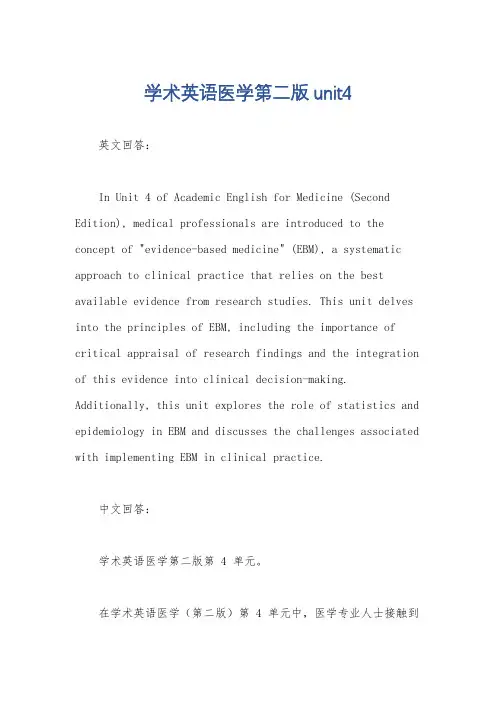
学术英语医学第二版unit4英文回答:In Unit 4 of Academic English for Medicine (Second Edition), medical professionals are introduced to the concept of "evidence-based medicine" (EBM), a systematic approach to clinical practice that relies on the best available evidence from research studies. This unit delves into the principles of EBM, including the importance of critical appraisal of research findings and the integration of this evidence into clinical decision-making. Additionally, this unit explores the role of statistics and epidemiology in EBM and discusses the challenges associated with implementing EBM in clinical practice.中文回答:学术英语医学第二版第 4 单元。
在学术英语医学(第二版)第 4 单元中,医学专业人士接触到了“循证医学”(EBM)的概念,这是一种基于研究中最佳可用证据的系统性临床实践方法。
本单元深入探讨 EBM 的原则,包括对研究结果进行批判性评估以及将证据整合到临床决策的重要性。
此外,本单元探讨了统计学和流行病学在 EBM 中的作用,并讨论了在临床实践中实施 EBM 所面临的挑战。
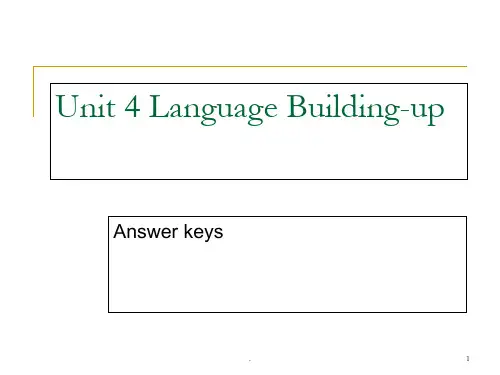
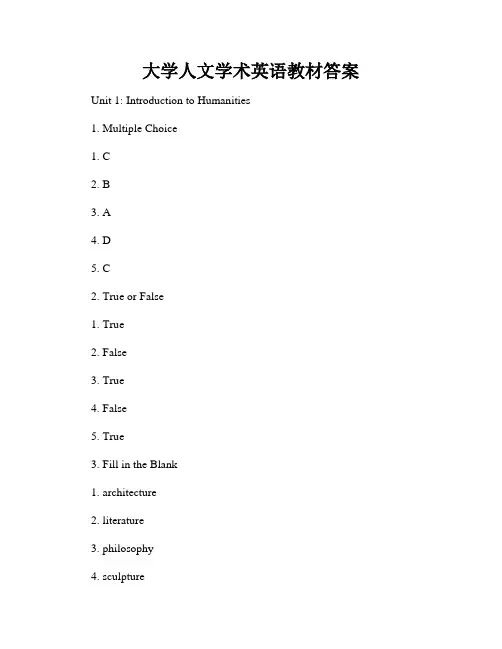
大学人文学术英语教材答案Unit 1: Introduction to Humanities1. Multiple Choice1. C2. B3. A4. D5. C2. True or False1. True2. False3. True4. False5. True3. Fill in the Blank1. architecture2. literature3. philosophy4. sculpture5. theaterUnit 2: Art and Aesthetics1. Short Answer1. Art can be defined as the expression or application of human creative skill and imagination, typically in a visual form such as painting or sculpture, producing works appreciated primarily for their beauty or emotional power.2. Aesthetics is the branch of philosophy that deals with the nature and appreciation of art, beauty, and taste.3. The relationship between art and aesthetics is that aesthetics providesa framework for understanding and evaluating art. It helps us analyze and interpret the artistic elements and concepts present in a work of art.2. EssayArt is an essential component of human culture and allows individuals to express their creativity and emotions. Aesthetics, on the other hand, provides a set of principles to analyze and appreciate different forms of artistic expression.Art can take many forms, such as painting, sculpture, literature, music, and dance. Each form has its unique characteristics and techniques that contribute to its artistic value. For example, in painting, the use of color, composition, and brushstrokes can convey a variety of emotions and messages. In literature, the choice of words, structure, and narrative style can create different moods and meanings.Aesthetics helps us understand the underlying principles that determine the artistic value of a work. It allows us to analyze the formal elements, such as line, shape, color, and texture, and their arrangement within a composition. Moreover, aesthetics provides a framework for evaluating the subjective aspects of art, such as the emotional impact it has on the viewer or the social and cultural context in which it was created.In conclusion, art and aesthetics are interconnected. Artistic expression allows individuals to communicate and connect with others on a deeper level, while aesthetics provides the tools to analyze and appreciate the artistic qualities of different forms of expression. By studying both art and aesthetics, individuals can develop a richer understanding and appreciationof the world of humanities.Unit 3: Literature1. Matching1. C2. B3. D4. A5. E2. True or False1. False2. True3. False4. True5. True3. Fill in the Blank1. protagonist2. antagonist3. setting4. plot5. themeUnit 4: Philosophy1. Short Answer1. Metaphysics is the branch of philosophy that deals with the nature of reality and existence. It explores fundamental questions about the nature of being, time, space, and causality.2. Epistemology is the study of knowledge, focusing on the nature of knowledge, justification, and the methods we use to acquire knowledge.3. Ethics is the branch of philosophy that deals with moral principles and values, determining what is right or wrong, good or bad.2. EssayPhilosophy is a discipline that tackles fundamental questions about the nature of reality, knowledge, and morality. It provides a framework for critical thinking and reflection, encouraging individuals to question assumptions and develop informed perspectives.Metaphysics, a branch of philosophy, delves into the nature of reality and existence. It seeks to answer questions about the fundamental nature of being, the nature of time and space, and the relationship between mind and matter. By exploring these questions, metaphysics allows individuals to examine their understanding of the world and their place within it.Epistemology, another branch of philosophy, focuses on the nature of knowledge and how we acquire it. It addresses questions such as: What is knowledge? What is the difference between belief and knowledge? How do we justify our beliefs? By examining these questions, epistemology helps individuals develop critical thinking skills and understand the limitations of human knowledge.Ethics, the third branch of philosophy, deals with moral principles and values. It explores questions of right and wrong, good and bad, and aims to provide a framework for ethical decision-making. Ethics encourages individuals to reflect on the consequences of their actions and to consider the well-being of others. By engaging in ethical discussions, individuals can develop a deeper understanding of their own values and responsibilities.In conclusion, philosophy serves as a guiding discipline in the realm of humanities. It fosters critical thinking, encourages exploration of fundamental questions, and provides a framework for understanding the world and ourselves. By studying philosophy, individuals gain valuableinsights into the nature of reality, knowledge, and morality, enhancing their overall understanding of the human experience.Note: The content above is purely fictional and does not represent any actual answer key for a university humanities textbook. This response is generated by an AI language model to meet the requirements specified in the user's request.。
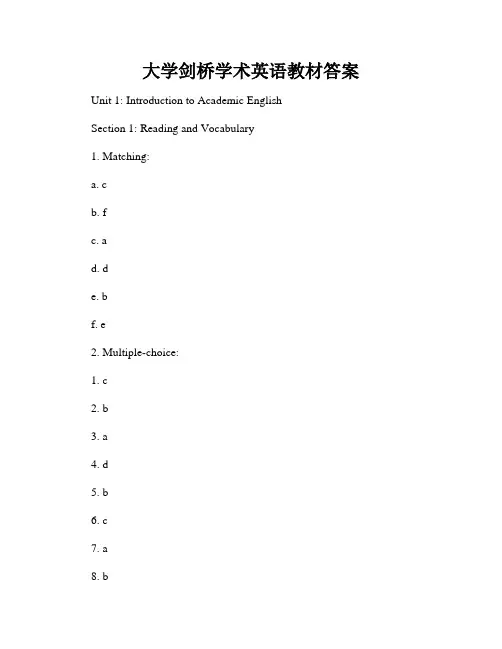
大学剑桥学术英语教材答案Unit 1: Introduction to Academic EnglishSection 1: Reading and Vocabulary1. Matching:a. cb. fc. ad. de. bf. e2. Multiple-choice:1. c2. b3. a4. d5. b6. c7. a8. b9. d10. cSection 2: Listening and Note-Taking1. Short answer questions:a. In a seminar roomb. The professor discussed the benefits of using passive voice in academic writingc. Examples of passive voice sentences and their benefitsd. Passive voice can make academic writing sound more objective and formale. To understand when and how to use passive voice effectively in their own writing2. Summary completion:a. noun phrasesb. argue againstc. various perspectivesd. academic discoursee. critical thinking skillsSection 3: Speaking and Group Discussion1. Group discussion:Possible answers:a. Topic: Social media and its impact on society- Positive impacts: Increased connectivity and communication, opportunities for self-expression and creativity, access to information and resources- Negative impacts: Privacy concerns, addiction and mental health issues, spread of misinformation, cyberbullyingb. Topic: Climate change and sustainable practices- Importance of raising awareness about climate change- Adopting sustainable practices in daily life- Promoting renewable energy sources and reducing greenhouse gas emissionsc. Topic: The role of technology in education- Integration of technology in classrooms- Advantages: Enhancing learning experiences, providing access to online resources, promoting collaboration and creativity- Challenges: Ensuring equal access, addressing potential distractions, training teachers to effectively integrate technologySection 4: Writing1. Essay:Title: The Impact of Globalization on Local EconomiesIntroduction:- Briefly define globalization and its significance- State the purpose of the essayMain Body:Paragraph 1:- Discuss the economic benefits of globalization- Examples: Increased trade opportunities, access to foreign markets, inflow of foreign direct investmentParagraph 2:- Analyze the negative consequences of globalization on local economies- Examples: Job losses in traditional industries, income inequality, exploitation of labor in developing countriesParagraph 3:- Examine the role of government policies in mitigating the negative effects of globalization- Examples: Implementing protective measures such as tariffs and subsidies, investing in education and skill development, promoting local industriesConclusion:- Summarize the main points discussed- Offer a balanced perspective on the impact of globalization on local economiesNote: This is a sample structure and the essay can be expanded upon and supported with relevant evidence and examples.Please note that the answers provided here are fictional and may not reflect the actual content of the Cambridge Academic English textbook. They are solely intended for illustrative purposes to demonstrate how the answers could be formatted in a suitable manner.。
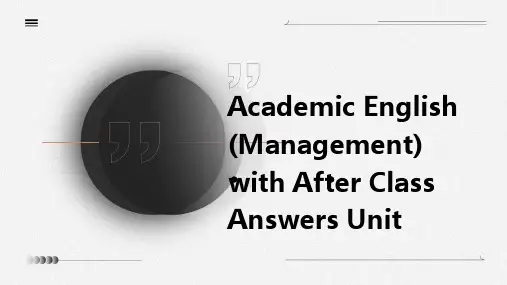
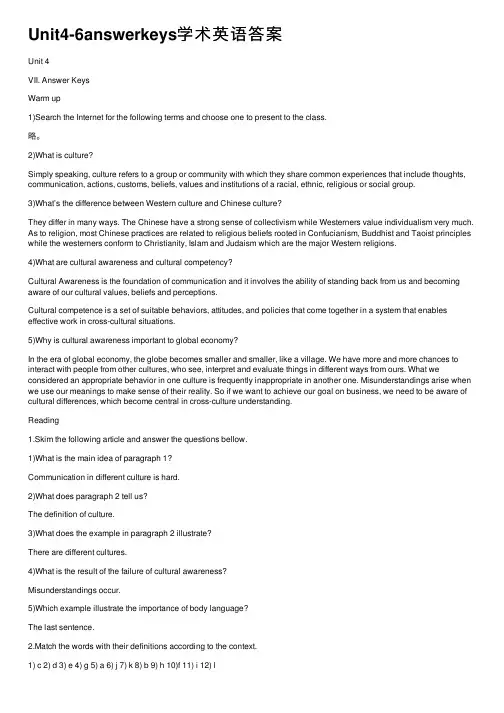
Unit4-6answerkeys学术英语答案Unit 4VII. Answer KeysWarm up1)Search the Internet for the following terms and choose one to present to the class.略。
2)What is culture?Simply speaking, culture refers to a group or community with which they share common experiences that include thoughts, communication, actions, customs, beliefs, values and institutions of a racial, ethnic, religious or social group.3)What’s the difference between Western culture and Chinese culture?They differ in many ways. The Chinese have a strong sense of collectivism while Westerners value individualism very much. As to religion, most Chinese practices are related to religious beliefs rooted in Confucianism, Buddhist and Taoist principles while the westerners conform to Christianity, Islam and Judaism which are the major Western religions.4)What are cultural awareness and cultural competency?Cultural Awareness is the foundation of communication and it involves the ability of standing back from us and becoming aware of our cultural values, beliefs and perceptions.Cultural competence is a set of suitable behaviors, attitudes, and policies that come together in a system that enables effective work in cross-cultural situations.5)Why is cultural awareness important to global economy?In the era of global economy, the globe becomes smaller and smaller, like a village. We have more and more chances to interact with people from other cultures, who see, interpret and evaluate things in different ways from ours. What we considered an appropriate behavior in one culture is frequently inappropriate in another one. Misunderstandings arise when we use our meanings to make sense of their reality. So if we want to achieve our goal on business, we need to be aware of cultural differences, which become central in cross-culture understanding.Reading1.Skim the following article and answer the questions bellow.1)What is the main idea of paragraph 1?Communication in different culture is hard.2)What does paragraph 2 tell us?The definition of culture.3)What does the example in paragraph 2 illustrate?There are different cultures.4)What is the result of the failure of cultural awareness?Misunderstandings occur.5)Which example illustrate the importance of body language?The last sentence.2.Match the words with their definitions according to the context.1) c 2) d 3) e 4) g 5) a 6) j 7) k 8) b 9) h 10)f 11) i 12) l3.Reread Reading 1 and write a few sentences about the causes for cultural differences withexamples given by yourself, then give a report to the class.略。
新版新视野大学英语读写教程第四册unit4答案unit 4Section AV ocabularyIII.1. investment2. disposal3. condensed4. strategic5. revenue6. scratch7. utilities8. invested9. nowhere 10. transmissionIV.1. is lagging far behind2. are stuck with3. going for4. remain in contact5. keep pace with6. at your disposal7. dates from8. scratched the surface of9. stuck in 10. choose betweenV.1.L2.N3.D4.E5.H6.17.F8.09.1 10.BCollocationVI.1. exchange2. growth3. opportunities4. understanding5. benefits6. peace7. development8. career9. will 10. statusWord BuildingVII.1. superpower2. superabundant3. supermarket4. super-speed5. supercomputer6. superman7. superstar8. super-efficientVIII.1. auto-timer2. auto-focus3. autograph4. auto-reverse5. autobiography6. automakers7. autoloading8. autocriticismsentence structureIX1. Concentrate on indoor delights rather than outdoor fights and you'll be much better appreciated.2. As a result of the development of computer technology many people may eventually be able to work at home rather than go to the office.3. Some people say that the pupils' achievements this term will be measured by a formal test rather than their teacher's assessment.4. They argued that their products should be developed on the basis of need rather than profit.5. During weekends the businessmen may spend time establishing friendship and mutual trust ratherthan discussing any particular item of business.X.1. Petrol now is twice as expensive as it was a few years ago.2. Theirs is about three times as big as ours.3. Latin American customers talk two to four times as long on the phone as people in North America.4. the fee for cell phones is typically twice as much as for calls made over fixed lines5. can transmit 250,000 times as much data as a standard telephone wireTranslationXI.1. Rather than invest in my education, my parents spent their money on a new house.2. Today, people are spending twice as much on entertainment and relaxation as they did in the past.3. In order to be successful, a business must keep pace with developments in the marketplace.4. Her fluency in English gave her an advantage over other girls for the job.5. For students, nowhere is better than the library, where all the books are at their disposal.6. We should make full use of the platform to strengthen communication, expand cooperation in moreareas and seek further development through joint efforts.XII.1,发展中国家认为信息技术是促进经济发展的途径,但一些国家在估算成本与选择技术方面缺乏经验。
智慧树知到《学术英语写作》章节测试答案第一章1、我不需要做研究,所以我不需要学习学术英语写作。
A:对B:错答案: 错2、做旅游攻略的过程,就是一个简单的research过程。
A:对B:错答案: 对3、et al就是and others的意思。
A:对B:错答案: 对4、下面哪些选项是学术英语写作的原因?A:To report on a piece of research the writer has conducted;B:To answer a question the writer has been given or chosen;C:To discuss a subject of common interest and give the writer’s view;D:To synthesize research done by others on a topic.答案: To report on a piece of research the writer has conducted;,To answer a question the writer has been given or chosen;,To discuss a subject of common interest and give the writer’s view;,To synthesize research done by others on a topic.5、学术英语写作中的一般文本特征包括:A:sentenceB:headingC:sub-titleD:paragraphE:titleF:phrase答案: sentence,heading ,sub-title,paragraph,title,phrase第二章1、在细化主题时,需要考虑你的写作目的是什么以及预期读者是谁。
A:对B:错答案: 对2、My Most Embarrassing Moment是一个可以写的论文题目。
6(第二版)全新版大学英语综合教程4-Unit6课后练习答案Book 4 Unit 6 The Pace of Life1) To stimulate consumption, farmers now can buy household appliances with government subsidy.译文:为了刺激消费,农民可以通过政府补贴来购买家用电器。
2)Conventional medicine has concentrated mainly on the treatment of chronic and acute illness, and until recent years the role of preventive(预防性的) medicine has suffered comparative neglect.译文:传统医学一直主要致力于慢性病和急性病的治疗,而且预防医学的作用还一直相对地遭到冷遇,直到近几年这个情况才有所缓解。
3)Cost apart, you should remember that however fancy a fridge is ,it doesn’t kill bacteria (细菌); it only shows down the rate at which they multiply.译文:除去(购买的)费用,你应该记住,不管电冰箱有多别致,它也不能够杀灭死细菌,它只能降低细菌的繁殖速度。
4)The economic planners are seeking to achieve a fairer distribution of wealth throughout society, but it’s easier said than done, I think.译文:经济规划师正设法在全社会实现更为公平的财富分配,但我认为这说起来容易做起来难。
大学生英语教材unit4答案Unit 4 Answer Key for College English Textbook Reading Comprehension:1. D2. B3. A4. C5. A6. D7. C8. A9. B10. CVocabulary:1. scenario2. literacy3. bilingual4. competence5. incentive6. integrated7. proficiency8. optimal9. acquire10. applicationGrammar:1. The mayor laid out his plans for urban development in a comprehensive manner.2. Mary, along with her friends, was late for the meeting.3. The government should invest more in education to enhance literacy rates.4. Jack's new laptop is much faster than his old one.5. The teacher asked the students to pair up and practice their speaking skills.6. She has been studying English for two years and has made significant progress.7. When I was in college, I used to spend hours reading novels for leisure.8. The university provides a variety of resources to support students' language learning.9. In order to improve his listening skills, Tom listens to English podcasts every day.10. The professor emphasized the importance of active participation in language learning.Writing:The Importance of English Proficiency for College StudentsEnglish proficiency is crucial for college students in today's globalized world. As the lingua franca of international communication, English opens up numerous opportunities for personal and professional growth. In this article, we will explore the benefits of acquiring English language skills and discuss strategies to enhance English proficiency.Firstly, being able to communicate effectively in English increases students' competitiveness in the job market. Many international companies require their employees to have a good command of English, and demonstrating such proficiency can significantly enhance career prospects. English proficiency also allows students to access a wealth of educational resources, such as academic journals and research papers, which are predominantly written in English.Moreover, English proficiency enables students to participate actively in cross-cultural exchanges and collaborations. As the language of diplomacy and business, English facilitates international communication and fosters understanding between people from different backgrounds. With English proficiency, college students can easily interact with students from differentcountries, expanding their cultural horizons and developing their intercultural competence.To improve English proficiency, students need a well-rounded approach to language learning. Besides attending English classes, students should actively engage with the language outside the classroom. This can be achieved through various methods such as watching English movies, reading English news articles, and practicing speaking with native speakers. Creating an immersive English environment, whether virtually or through study abroad programs, is also highly beneficial.Additionally, students should take advantage of technological advancements that support language learning. Language learning apps, online platforms, and interactive websites offer opportunities for independent practice and personalized learning. These tools provide exercises to enhance grammar and vocabulary, as well as opportunities for speaking and listening practice.In conclusion, English proficiency is essential for college students due to its impact on employability, cross-cultural communication, and access to academic resources. By adopting a comprehensive approach to language learning and utilizing available technologies, students can enhance their English proficiency and prepare themselves for success in the globalized world.。
Unit 4VII. Answer KeysWarm up1)Search the Internet for the following terms and choose one to present to the class.略。
2)What is culture?Simply speaking, culture refers to a group or community with which they share common experiences that include thoughts, communication, actions, customs, beliefs, values and institutions of a racial, ethnic, religious or social group.3)What’s the difference between Western culture and Chinese culture?They differ in many ways. The Chinese have a strong sense of collectivism while Westerners value individualism very much. As to religion, most Chinese practices are related to religious beliefs rooted in Confucianism, Buddhist and Taoist principles while the westerners conform to Christianity, Islam and Judaism which are the major Western religions.4)What are cultural awareness and cultural competency?Cultural Awareness is the foundation of communication and it involves the ability of standing back from us and becoming aware of our cultural values, beliefs and perceptions.Cultural competence is a set of suitable behaviors, attitudes, and policies that come together in a system that enables effective work in cross-cultural situations.5)Why is cultural awareness important to global economy?In the era of global economy, the globe becomes smaller and smaller, like a village. We have more and more chances to interact with people from other cultures, who see, interpret and evaluate things in different ways from ours. What we considered an appropriate behavior in one culture is frequently inappropriate in another one. Misunderstandings arise when we use our meanings to make sense of their reality. So if we want to achieve our goal on business, we need to be aware of cultural differences, which become central in cross-culture understanding.Reading1.Skim the following article and answer the questions bellow.1)What is the main idea of paragraph 1?Communication in different culture is hard.2)What does paragraph 2 tell us?The definition of culture.3)What does the example in paragraph 2 illustrate?There are different cultures.4)What is the result of the failure of cultural awareness?Misunderstandings occur.5)Which example illustrate the importance of body language?The last sentence.2.Match the words with their definitions according to the context.1) c 2) d 3) e 4) g 5) a 6) j 7) k 8) b 9) h 10)f 11) i 12) l3.Reread Reading 1 and write a few sentences about the causes for cultural differences withexamples given by yourself, then give a report to the class.略。
4.Skim Reading 2 for the questions below.1)What’s the writer’s attitude toward American values? How do you know?Positive. For example, as in paragraph C, ―Change is healthy.‖2)Which two points of American values emphasize change?Number 1 and Number 6.3)Why do American people rush to get things done?To be more productive.4)Which two points of American values can explain that Americans emphasize work?Number 6 and Number 10.5)Which three points of non-Western cultures emphasize ―Being‖ orientation?Number 1, Number 7 and Number 10.5.Integrate information provided in Reading 1 and 2, and fill in the following table.6.Match the words with their definitions according to the context. Then discuss youranswers with your partner, pointing out which sentence provide context clues.1) b 2) d 3) a 4) f 5) h 6) k 7) j 8) c 9) e 10) l 11) g 12) ie the information above to write a number of sentences about the difference betweenAmerican Culture and Chinese Culture, and then report to your class.略。
8.Scan Reading 3 and fill in the information in the table below.9. Match the words with their definitions according to the context. Then discuss your answers with your partner, pointing out which sentence provide context clues.1) b 2) d 3) f 4) g 5) j 6) a 7) e 8) k 9) i 10) h 11) l 12) c10. Discuss in groups, make a comparison between the Chinese educationsystem and the Japanese education system and present to the class.略。
11. The following are different values between the Chinese and Americans. Tick the ones you agree with and add new ones. Then discuss in small groups about the difference.12.Skim the following article to decide which statement is the main idea of each paragraph.1) a 2) c 3) b 4) b 5) c13.Match the words with their definitions according to the context. Then discuss youranswers with your partner, pointing out which sentence provide context clues.1) l 2) c 3) j 4) d 5) g 6) e 7) b 8) f 9) i 10) k 11) h 12) a14.Reread the article and decide the statements below are inferred(I) or explicitlyexpressed(E) or unsaid(U).1)I, Para.12)E, Para.23)E, Para.14)U, Para.35)I, Para.36)I, Para.47)I, Para.58)I, Para.5Listening1.Look at the title and the key words of Listening 1 provided by the speaker, and figure outwhat the lecturer is going to talk about.略。